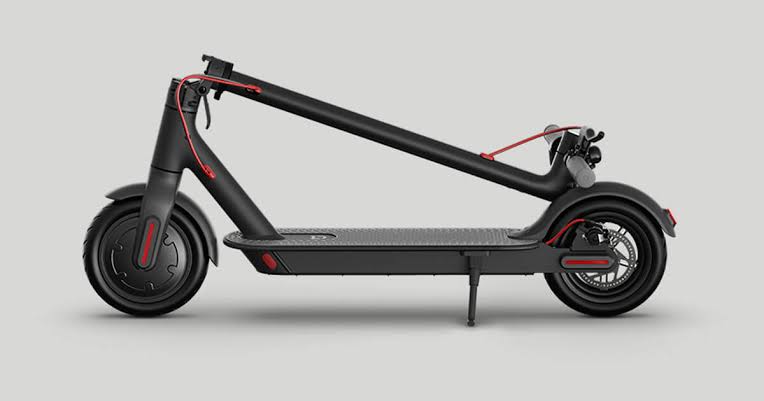The Xiaomi Mi Scooter 1S has been one of the most popular e-scooters in Germany since it was released in 2020. Now it’s reduced again at MediaMarkt for €389 and Saturn for €389. The deal is only valid until June 1st. valid at 8:59 a.m. so get in quick. The offer is over, the scooter is now the cheapest at Odiporo for 429€.
- street legal
- 30 km range
- 12.5 kg light
It could be one of the last offers for the scooter because with the release of the Xiaomi Scooter 3 there is already a successor. It is currently also reduced and only slightly more expensive at €469. In this case, it might be more worthwhile to use the model that is two years newer.
The Xiaomi fans among the e-scooter drivers have been waiting for this for a long time: Finally there is an officially approved version of the Xiaomi Scooter M365 in Germany. The Xiaomi Mi E-Scooter 1S hasn’t even gotten much more expensive, but it keeps the familiar design and even has a few upgrades. We got one of the scooters ourselves and tell you everything you need to know about the Mi Scooter 1S – and where you can buy it.
Xiaomi Mi Scooter 1S Review, Specs & Price
- Mi Scooter 1S
- Xiaomi Electric Scooter 4 Pro
- Specifications of the Mi Scooter 1S
| Maximum range | 30km |
| Maximum speed | 20km/h |
| Maximum transport weight | 100kg |
| battery | Lithium ion 36 volts, 275 Wh |
| engine power | no |
| own weight | 12.5kg |
| Dimensions (length/width/height) | 114x43x108cm |
| street legal | Yes |
| Price | 449€ |
In order to comply with the eKFV, the speed is of course reduced to a maximum of 20 km/h. The range is given as a decent 30 kilometers – for operation in the city, that’s enough to only have to charge it every few days even with daily use, although this of course depends heavily on the distance driven. In my experience so far, the scooter never quite reaches 30 kilometers (simply because it slows down significantly before the battery is completely empty). Nevertheless, the range is completely fine here.
Changes to the exterior of the scooter are mainly found on the rear wheel, where there is now a rear light and space for an insurance license plate. However, the Mi E-Scooter retains its typical design with the well-known shape of the handlebar. There is also a display in the handlebars.
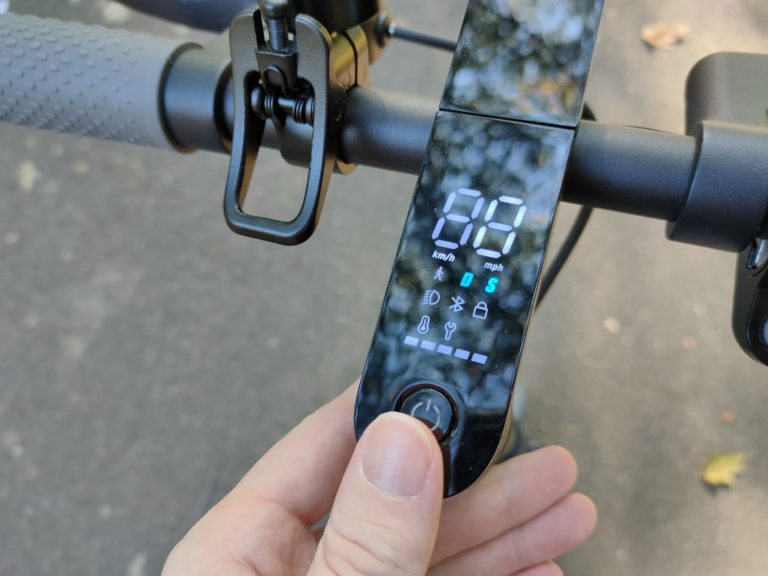
The display shows you the speed and the currently active mode. The other symbols show whether the light is switched on, whether there is an active Bluetooth connection to a smartphone and whether the scooter is locked. The last two symbols are warnings if the temperature is too high or there is a defect. The five bars at the bottom show the battery status.
Of course, the scooter has the required lighting and two separate braking systems. There is a mechanical disc brake and an electric brake. The tires are 8.5 inches.
There’s also app support again. You can use your smartphone to call up your driving data and lock the scooter.
Mi Scooter Pro 2
The Mi Scooter Pro 2 is largely identical to the Mi Scooter 1S. The only difference is a larger battery, which results in a longer range of around 45 kilometers. In addition, the scooter is about 2 kg heavier.
We only tested the Mi Scooter 1S, so all statements here only refer to this model. However, one can assume that in terms of quality and reliability, you will get the same with both models. If you don’t really need the 15 kilometer range anymore, you’d probably be better off with the 1S.
Design and finish of the scooter
On the outside, as already mentioned, not much has changed. At first glance, the scooter can be recognized as a Xiaomi model, which is mainly due to the shape of the handlebars. At the latest, however, the orange-colored Mi logo on the bar or the Mi lettering on the running board clearly state what you are dealing with here.
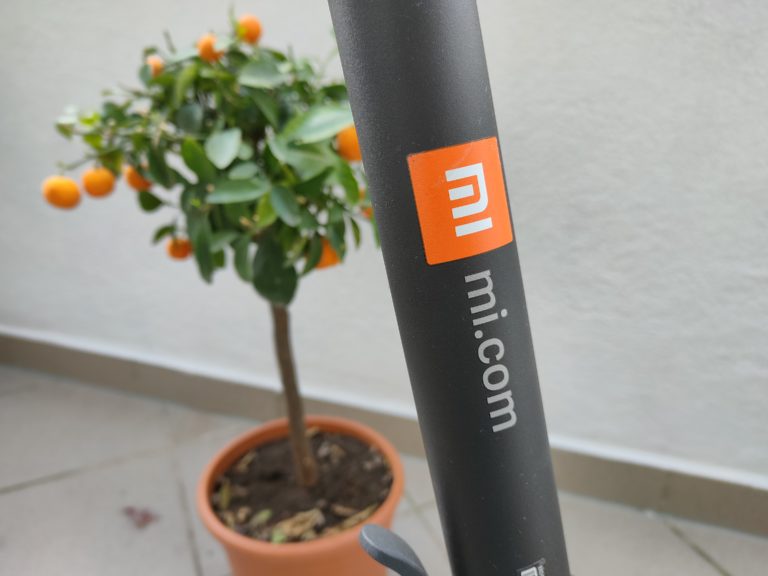
Lighting
Of course, safety is one of the most important aspects of an e-scooter. Without the prescribed lighting, no scooter is street legal, which is why it is now fully available at Xiaomi. The front and rear lights can be switched on at the push of a button, which should be done when dusk falls. The app can also be used to set the rear light to remain on all the time.

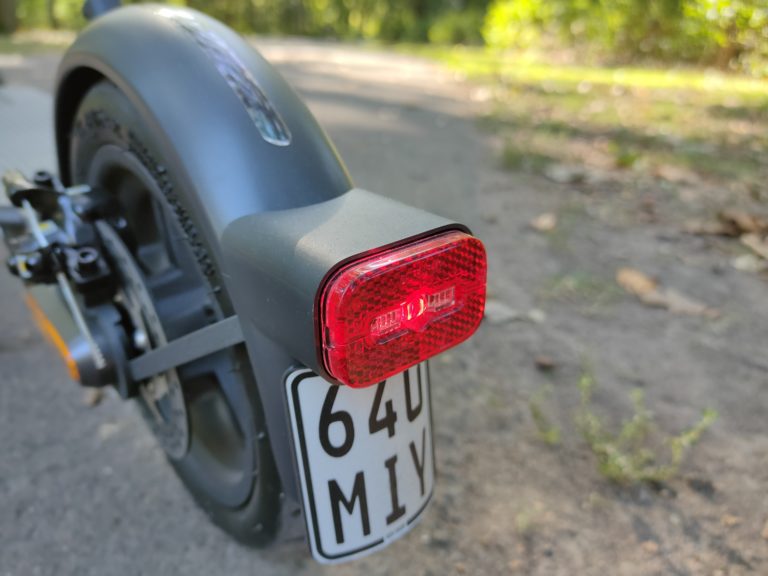
There are side reflectors on both the front and rear wheel. There is also a forward-facing reflector above the front wheel.
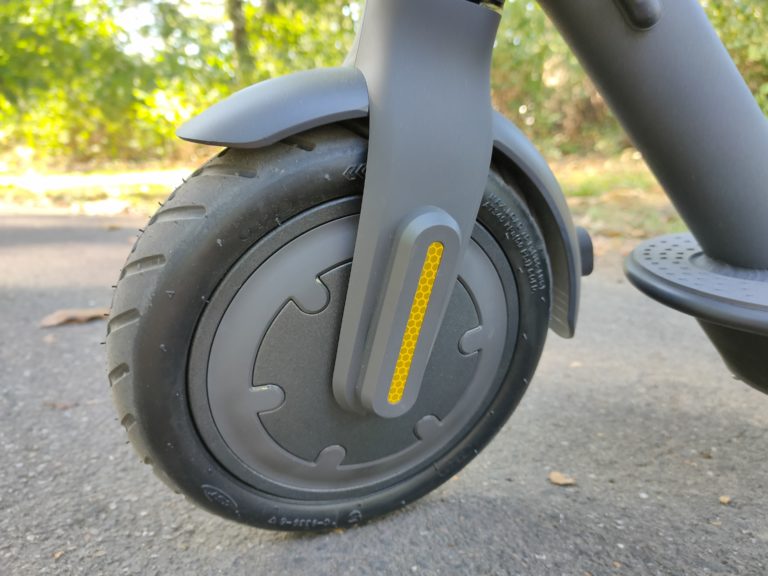
Brakes
The brakes are at least as important as the lighting. As stipulated, there are two braking systems that work independently of one another – a mechanical train brake and an electronic brake. Interesting innovation: instead of being operated as before, the electronic brake is not operated by a small lever (operated with the thumb) at the level of the throttle. Instead, there is a classic brake lever like a bicycle brake. Not only does it look better, the brakes are so much easier to reach and braking is more intuitive.
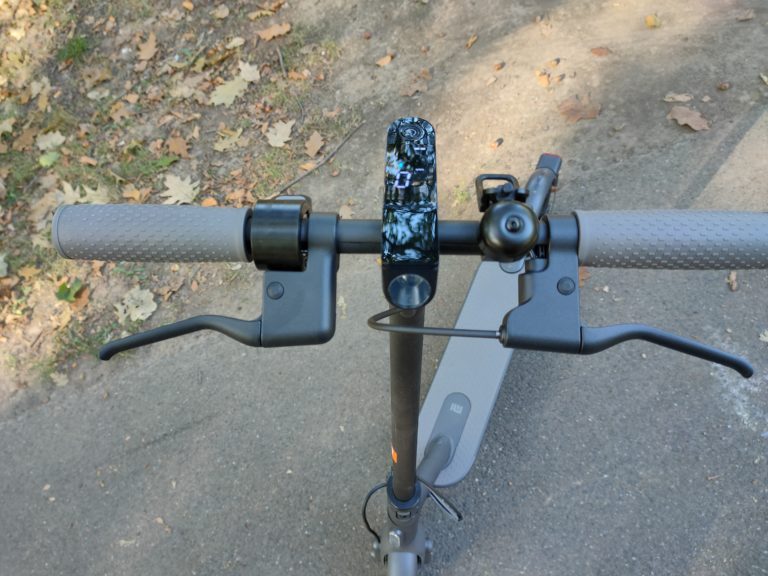
However, caution is advised here. The electronic brake brakes very abruptly. The sudden braking will surprise you, especially the first time; so be sure to try it at a slower pace first. Another tip (which applies to all e-scooters) is: Be sure to bend your knees slightly when you brake hard. So that you can do this automatically in an emergency, you should consciously pay attention to this when braking while driving and practice it. I’m serious: If you fully depress both brakes (or even just the e-brake) and stand stiffly at 20 km/h with the scooter, then you will fall.
What now sounds dangerous is really only intended as a well-intentioned tip for emergencies. The brakes work well and there is nothing wrong with them, but they do take some getting used to. Hopefully, after you’ve been on the scooter for a while, most of it will take care of itself.
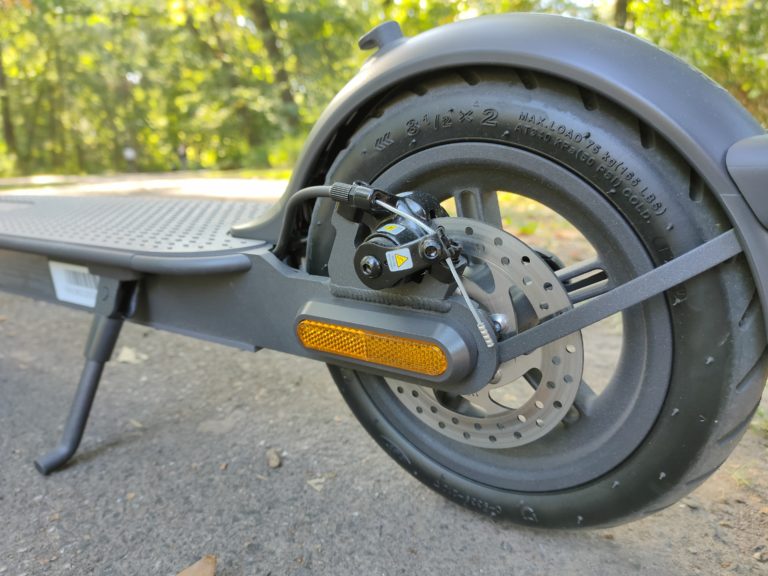
The train brake is less jerky and is also located on the rear wheel, making braking a little more comfortable. I prefer to use this brake while driving. If you drive carefully and always take your foot off the gas in good time, in most cases you probably won’t need the brakes at all. With maximum energy recovery set (goes in the app), the scooter slows down after about 15 meters from 20 km/h to walking speed without you braking.
Tires
These are pneumatic tyres, which means that there is a tube inside the rubber tire that needs to be filled with air. You can also see that from the existing valves. When you receive the scooter, the tires are already sufficiently inflated and I have not had to add air yet. But keep an eye on it and refill if necessary.
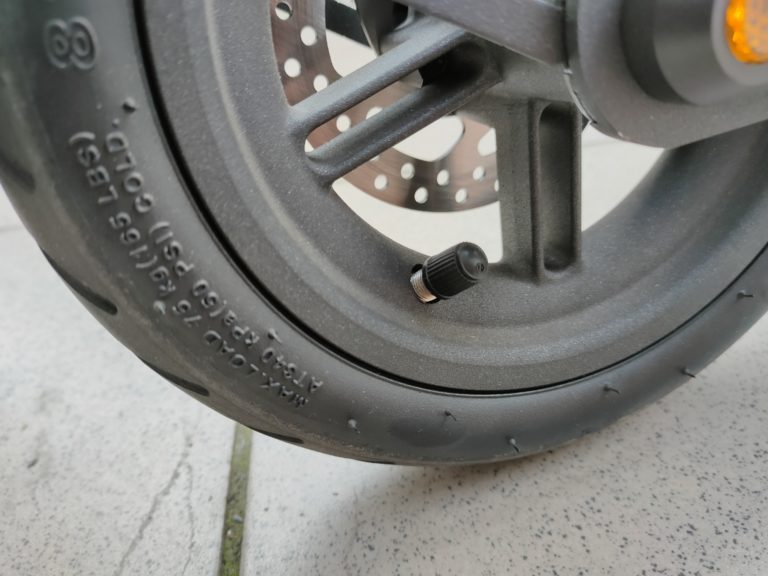
It is generally a bit more comfortable to drive on pneumatic tires than on solid rubber tires, but a “flat tire” is theoretically possible. It is very pleasing that Xiaomi even includes a replacement jacket including a hose.
The tires measure 8.5 inches in diameter, which is standard for e-scooters. Especially compact scooters often have smaller tires; you rarely find larger ones, such as the 10 inch tires on the Ninebot G30D. Larger tires are actually always preferable, because the smaller the tires, the more you notice every bump in the ground. You shouldn’t drive at full speed even over low curbs, even the softer pneumatic tires won’t help.
Folding and transport
The scooter can be folded, i.e. the entire handlebar is folded down. There is a lock with a large lever, which is additionally secured by a small safety lever. Unintentional folding is thus as good as impossible. When folded, the scooter is approx. 48 cm high at the highest point.
As usual (just about every scooter has this feature), a buckle on the bell snaps onto a hook on the rear wheel. The handlebar becomes a carrying handle for the scooter. With a weight of 12.5 kg, it can also be carried reasonably comfortably. At least the way from the trunk to the front door or through the station to your seat on the train is no problem. I remember my experience with the 19.5 kg Ninebot G30D, which although it drives incredibly well, was a pain to transport every time.
There’s a fold-out kickstand in the back third of the footboard, but there’s not much to say about it. If you take the scooter with you on the train, set it up parallel to the direction of travel, otherwise it will easily tip over if you don’t hold it tight.
Integration into the Mi Home App
The integration into the app is just as successful as with any other Xiaomi device. If you already have the app, you won’t have any problems and will find your way around quickly. Since this is a model that was officially released in Germany, you can simply select “Germany” in the country settings.
You need a Mi account to use the app and of course Bluetooth must be activated on your cell phone. The first time you start the app you have to activate the scooter. As long as you haven’t done this, the speed will remain throttled to 10 km/h and you will hear a regular beep. A short security video that cannot be skipped also plays during activation.
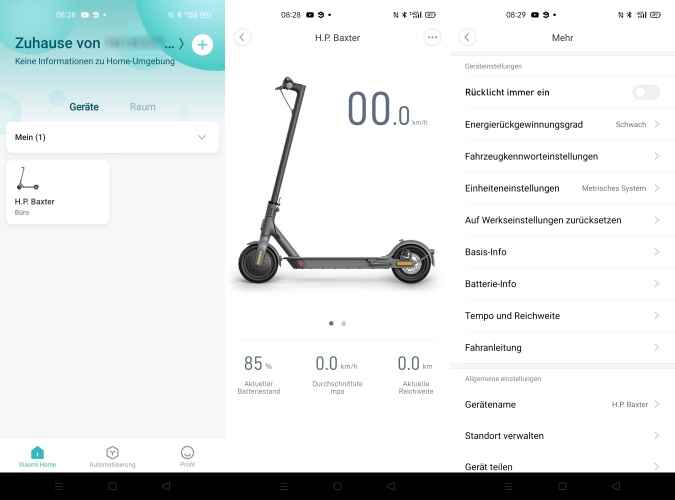
First of all, the app simply gives you an overview of all product data such as serial numbers and firmware version. You also have a few setting options. You can lock the scooter directly on the main screen by simply swiping to the right. The scooter then becomes difficult to push and emits a warning signal when it is moved.
In the settings, which you get to via the small icon in the top right, you can then also switch on the rear light, adjust the level of energy recovery (how much the scooter brakes by itself and thus recovers energy) or switch from metric to imperial (for whatever reason you should do this).
Energy recovery means that as soon as you take your foot off the gas, the scooter converts the kinetic energy back into electrical energy. The battery doesn’t last much longer, but this effectively means that you brake much harder as soon as you take your foot off the gas. When set to “low”, you can still roll out quite a bit, while the scooter slows down to walking speed after about 15 meters when the energy recovery is set to “high”. Below 5 km/h, however, this no longer has any effect and the scooter rolls out normally.
You will also get all sorts of information about the condition of the battery. In addition to the battery status in percent and the estimated remaining range, the temperature is also displayed.

The display of the current speed is a bit unnecessary, since you will hopefully have the smartphone in your pocket while driving and not hold it in your hand. You could attach it to the handlebars with a bracket, but you still have the display to show the speed. So far, there has been no tracking of the route driven, and an average speed has not yet been displayed.
Riding the Xiaomi Mi Scooter 1S
I want to mention two different things here. On the one hand it should be about the general features and modes, i.e. what the scooter can do on paper. But then I will also say something about the driving experience, something that is difficult to quantify but which I think is still important.

3 different modes
We’re used to that by now – almost every e-scooter comes with such different settings. While sometimes this only impacts acceleration and energy savings, there are also three distinct speeds here. You cycle through modes by double-pressing the button on the display (like a “double-click”).
In Pedestrian Mode, i.e. the pedestrian mode, the speed is limited to 5 km/h. This mode is indicated by a pedestrian symbol on the display. Even if you fully depress the throttle here, you will not go faster than 4-6 km/h. In my experience, that varies quite a bit. Especially on downhill stretches you can easily manage 6 km/h, sometimes you can hardly manage 4 km/h, which then feels almost ridiculously slow when overtaking a pedestrian.
The idea here is perhaps not to be faster than pedestrians in pedestrian zones or on sidewalks (where, strictly speaking, you are not allowed to drive anyway). In my experience, however, this works better if you adjust the tempo yourself. The mode is actually already too slow that you’re almost better off pushing. Unfortunately, the speed cannot be adjusted.

In the second mode, the “Normal Mode” , indicated by a D on the display, you drive up to 15 km/h fast. This may be advisable if 20 km/h is too fast for you and you don’t feel safe with it. In addition, the battery lasts a little longer. In my opinion, however, 15 km/h is too slow for moving around in the city, on cycle paths and on the road. I would almost always prefer 20 km/h here, especially since you can still control the speed yourself with the throttle if you want to drive slower in parts. Quite a few were even in favor of a 25 km/h speed limit for e-scooters.
Finally, there is the sport mode, recognizable by an S on the display. Here the acceleration is even better and the scooter can reach speeds of up to 20 km/h. While other models sometimes scratch the 21 km/h here, it really is 20 km/h. A Ninebot G30D, for example, overtook me despite the throttle being pushed down, but the driver also seemed to be lighter.
How does the Mi Scooter 1S really drive?
The Pedestrian Mode is a nice idea, but not really helpful. If I’m traveling with someone and want to ride next to them, the scooter is usually too slow for that, so I prefer to push or just ride in D-mode. This mode, on the other hand, is too slow for driving in traffic.
I’ve tried all modes, but apart from that I’m in S-Mode 99% of the time. In my opinion, it simply needs the 20 km/h. Cyclists overtake you all the time anyway, and on the road next to cars you feel a bit out of place anyway. If you then only drive 15, you can actually almost save yourself the scooter.
In general, however, I simply have to describe the “driving experience” as very good. The knobbed running board offers a secure footing and is just big enough for me (shoe size 43/44), even though I usually notice when driving that the ball of the front foot is already on the sloping connecting rod. The handles offer a good grip and the brakes are very easy to reach.
I also like the acceleration, the Mi Scooter 1S starts at about 3 km/h after pushing and reaches the top speed of 20 km/h in a few seconds on a straight stretch. The G30D and some rental scooters (especially the older TIER models) accelerate even better.
Insurance
Finally, a note about insurance. This is mandatory, and anyone who drives without insurance and license plates may even be liable to prosecution. Luckily, such an insurance is not very expensive and is usually less than 40€ per year. That depends on the age of the driver; usually there are gradations from 14, 18 or 23 years of minimum age.
Applying for insurance is very easy and can easily be done online. I don’t want to recommend any particular provider here, the processes are the same everywhere. Apply for the license plate online and it will be sent to you within a few working days. Then all you have to do is stick it on the holder provided at the back and you can start driving. Precisely because it is really not expensive and protects you from high costs in the event of damage, I recommend everyone to take out this insurance.
Conclusion on the Xiaomi Mi Scooter 1S
“Finally” many will say. While many manufacturers are based on the design of the M365 (e.g. the Doc Green ESA 5000 we tested ), nothing has come from Xiaomi itself so far. Now that is changing, which goes well with the fact that Xiaomi seems to be focusing more on the German market. The first Xiaomi store in Germany has now opened in Düsseldorf after a delay caused by Corona. By the way, the Mi Scooter 1S can also be bought there.
My verdict on the scooter: It’s just as good as the M365 – and even better. In order to meet the requirements of the e-scooter regulation, safety has been further improved with additional lighting and better brakes. When specifying the range, nothing was embellished: Sure, 30 kilometers can only be achieved under ideal test conditions, but the value is almost reached.
Xiaomi can’t do anything about the fact that the scooter “only” drives 20, that’s the legal situation. I’ve had (and still have) a lot of fun with the scooter and it’s the closest I could have hoped for the scooter to be approved 1 1/2 years ago.
Since the price of 400-450€ is also completely fine, I can unconditionally recommend the Mi Scooter 1S to anyone who is looking for an e-scooter with street approval. Xiaomi Mi Scooter 1S Review video below:
